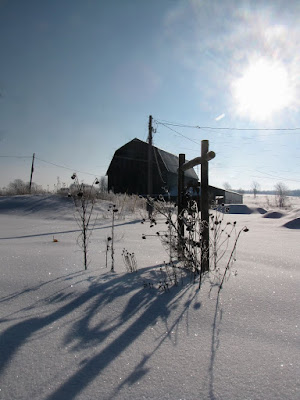It won't be long until it's time to plant potatoes in Potter County. We'd already ordered our seed potatoes when I read about this superlative spud described here by my grandfather, W.D. Fish in 1961:
"Early Rose potatoes – They were favorites when this old timer was a small boy, maybe more than sixty years ago.
When those old time spuds were cooked the skins cracked loose and they mashed dry and mealy, with a flavor –
They ain't no such potatoes today.
True, the yield of 100 bushels to the acre was a big crop, but it was a quality crop.
Today anything less than 400 bushels per acre is almost a crop failure, but who can eat the stuff!
The darned things are like trying to mash a mess of salve. Why, those Early Rose potatoes smiled at you – and as the skins cracked, they even laughed.
Wonderful food, appetizing, flavorful, nourishing and a delight to the sense of taste."
The internet pointed me to the Slow Food Foundation for Biodiversity where I found information about the Early Rose:
After its introduction by Albert Bresee in 1861, the Early Rose potato gained widespread popularity. By 1868, the potato was widely sold by B.K. Bliss and Sons of New York for $1 per pound. The Early Rose was prized for its resistance to blight, common pests, and its superior taste. It was one of the first commercially successful potatoes and contributed to the massive growth of the potato farming industry during the late 19th century. During the colonization of New England, potatoes sustained the people and were highly valued as a food source.
Like many heirloom plants, the Early Rose was relegated to obscurity by the production of cheaper, easier to grow potatoes like the Yukon Gold and Russet. The commercial viability of the Early Rose was diminished by the necessity of cool weather climates, which are not always present across North America. As the potato industry grew, taste was valued less than other attributes such as efficiency, low cost, uniform shape, durability in long distance shipment, long shelf life and ease of processing. These factors were valued over the rich flavor profile of the Early Rose and contributed to the diminishing nutritional value of the potato.
Heirloom potatoes are divided into two main textures, floury and starchy. The Early Rose falls into the starchy texture category. The taste of the potato is rich in consistency with a light potato flavor. The potato is considered a more balanced version of other red all-purpose varieties. It’s a good choice for all types of cuisine including salad, dumplings, soup, and sweet baked goods. The Early Rose is a great compliment to many other vegetables and can be mashed, roasted, boiled and included in casseroles.
The Maine Potato Lady, a source of organic seed potatoes, lists Early Rose and describes it as one of the founding potato varieties in this country. "Early maturing oval tubers have smooth red skin and white flesh, great for everything from steaming to baking. A true heirloom. "
Eureka! Ready to order and then ... "Not Available At This Time."
Next year I'll start earlier on the trail of the smiling potato.












